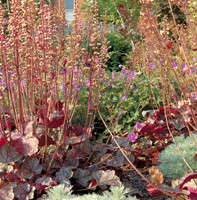Breeding A Stronger Heuchera

How does one go from a Ph.D. in the evolutionary genetics of butterflies and moths to establishing a well-respected breeding program for heucheras?
“It’s almost an accident,” says Martha Oliver of the career path her husband, Charles, found himself traveling in the 1980s. This near accident took Charles from the genetics of winged things to the genetics of native plants — with a detour in the field of water testing — and can partially be blamed on bees.
While operating a drinking water testing facility in western Pennsylvania, Charles and Martha Oliver were avid gardeners with a deep interest in native plants. The hobby soon pushed the nine-to-five job out of the way. The Primrose Path nursery and mail-order business began in 1984.
“I was just starting into the retail business, building up stock from seed for lots of plants,” Charles says. “I was getting heuchera hybrids out in the garden that didn’t look like anything I had seen before. I thought ‘Here’s a nice new set of plants to offer.'” Chance hybrids have given way to a controlled cross-breeding program for the heucheras, tiarellas, the bigeneric heucherellas, phlox and primulas. Charles’ breeding efforts have resulted in the Marcel LePiniec Award from the North American Rock Garden Society and several other awards for individual plants in Holland and England.
Since the mid 1980s, Charles has introduced more than 80 new plants to the trade. Many of these heucheras and tiarellas have native parentage that is tolerant of the rough climatic conditions of western Pennsylvania. Summers can be dry, and winters are cycles of sudden thaws and freezing rains and temperatures, with little insulating snow cover.
“Plants that do well in our trial gardens tend to do really well in everybody else’s gardens,” Charles says. “Our plants have extra vigor because they’ve survived our conditions. I would never have gotten our heucheras in the Adrian Bloom-designed garden on the OSU Columbus campus to look that gorgeous here.” Another testament to Oliver’s tough-as-nails heucheras: ‘Raspberry Ice’ is planted in full-sun conditions in that new Columbus garden and they are blooming with fervor.
The Olivers have had such success with their breeding program because they have clear-cut goals for their plants. “We think about the habit, vigor, flower size and color, and extending the length of bloom time — all the things that we think would make a perfect plant,” Charles says. “We have a goal in mind, and each plant we put on the market is a step toward that goal. One of the reasons there are so many heucheras coming out is that breeders haven’t reached their goals. People keep breeding something better than what they had before. I suppose after a certain amount of time we’ll get as far as we can go. I don’t think we are there yet.”
The Primrose Path is also working toward breeding heucheras with larger flowers and those whose foliage remains reliably purple throughout the growing season. Some of the genetics Charles draws from are gathered as seed from wild forms in the woods of western Pennsylvania.
“We’re fortunate to be in this place (western Pennsylvania) because there’s a tremendous amount of plant material to work with,” Martha says. The location’s harsh climate gives their varieties an extra dose of hardiness, they believe, that is an important competitive advantage over heucheras and tiarellas bred in the western United States.
“It’s not gene splicing or mad science. It’s just moving pollen with a paint brush from the two best parents,” Martha says. “This is how plant breeders have worked for thousands of years.” Their early crosses with tiarella, it should be noted, are the stock from which nearly all new hybrids have been derived. Charles gives credit to the father of famed British plantsman Adrian Bloom for establishing a foundation of heuchera varieties on which modern heuchera breeding is based.
“Heucheras were first bred for the cut flower market, and Alan Bloom started that,” Charles says. “What Bloom did was to go through the wild types early on to choose nice plants with good flowers. This gave us a very nice basic stock of green-leaved plants with good flowers and stem lengths as a starting point.” From there, Blooms of Bressingham, the Bloom family nursery, introduced one of the first purple- or bronzed-leaved varieties, ‘Palace Purple.’ “All the modern breeding started when ‘Palace Purple’ was crossed into the green-leaved varieties in the 1980s. All the best heucheras today have come from that basic Blooms stock,” says Charles.
The Primrose Path is now aligned with Blooms of Bressingham to market several of its plant introductions. “We’ve tried a number of other agents, and Blooms is by far the best of them, I think,” Charles says. “They do the basics of marketing very well.”








